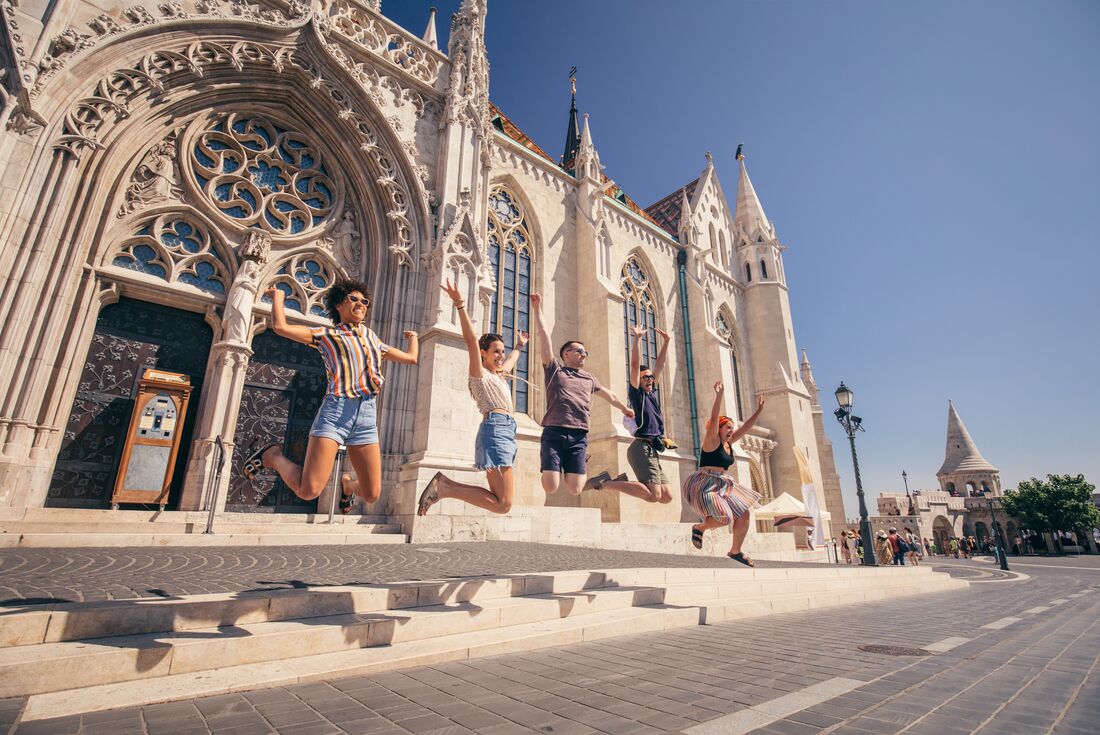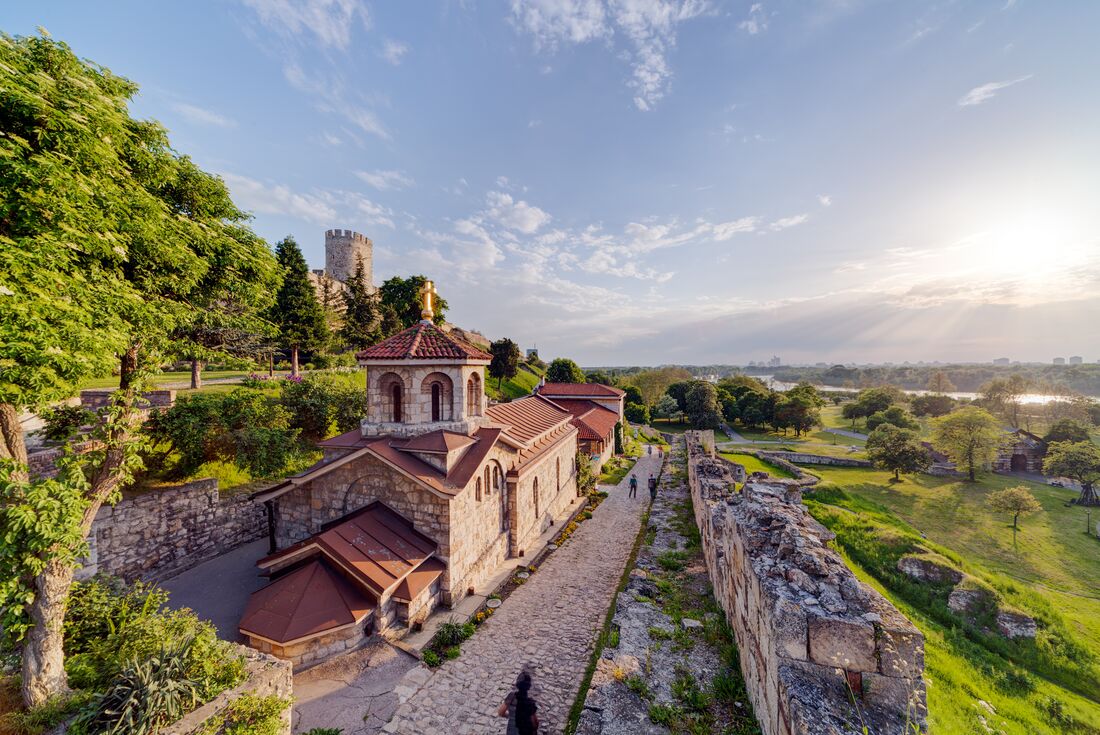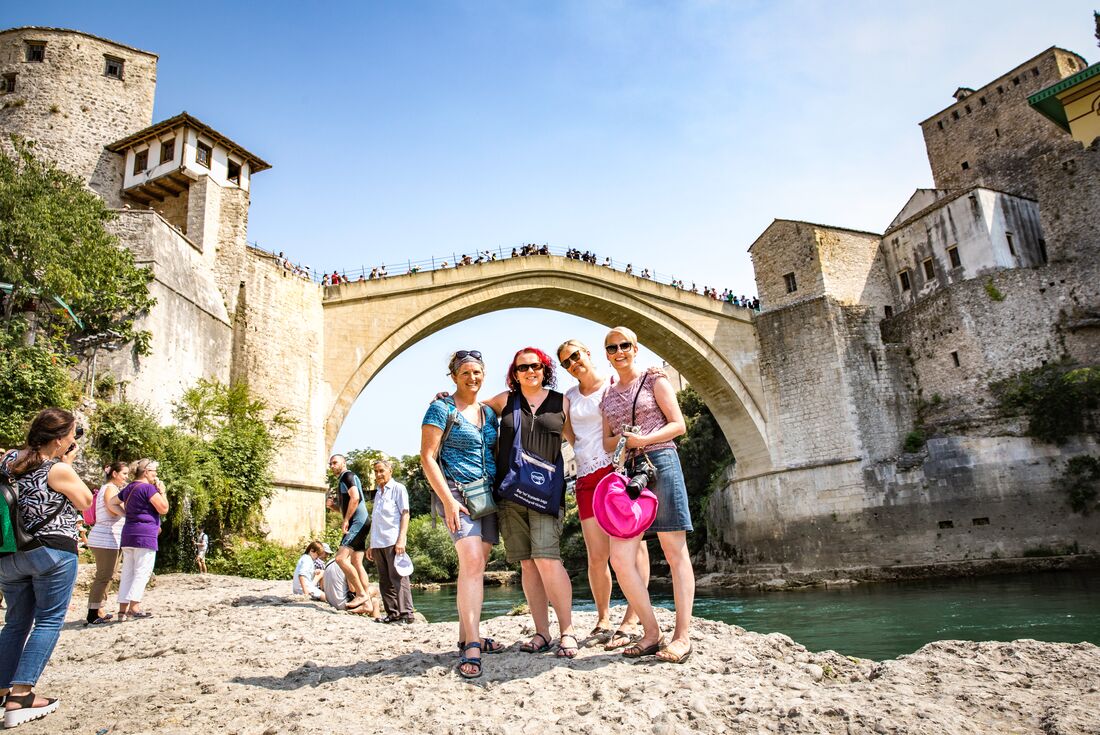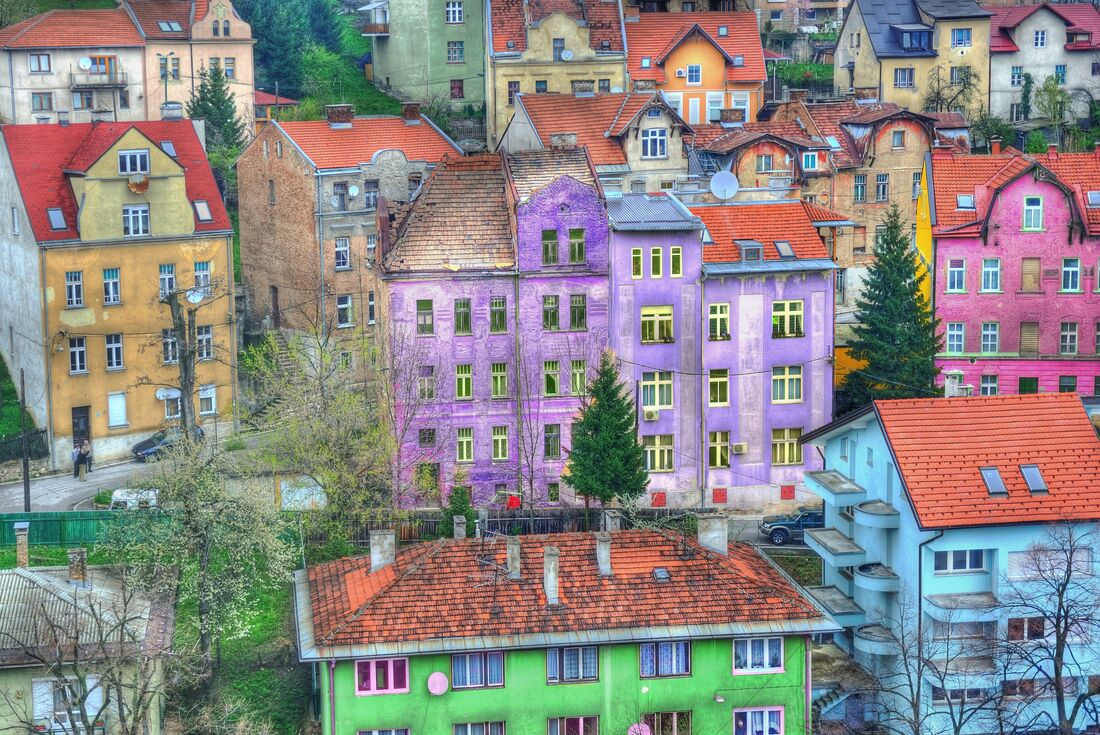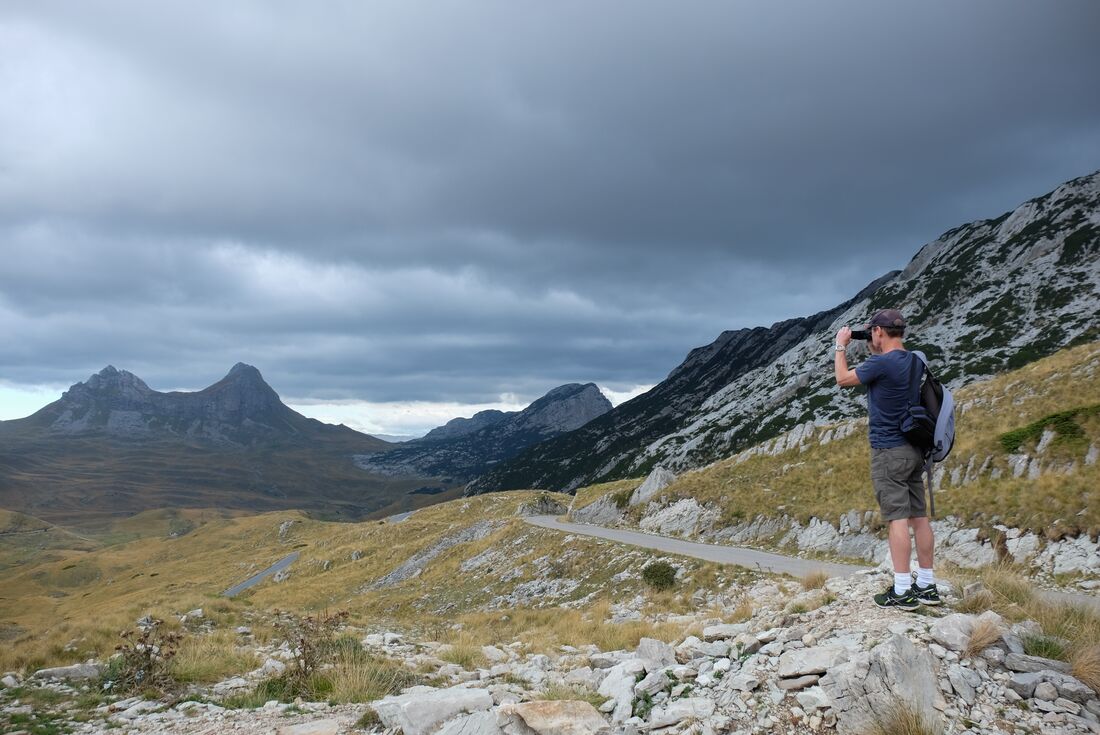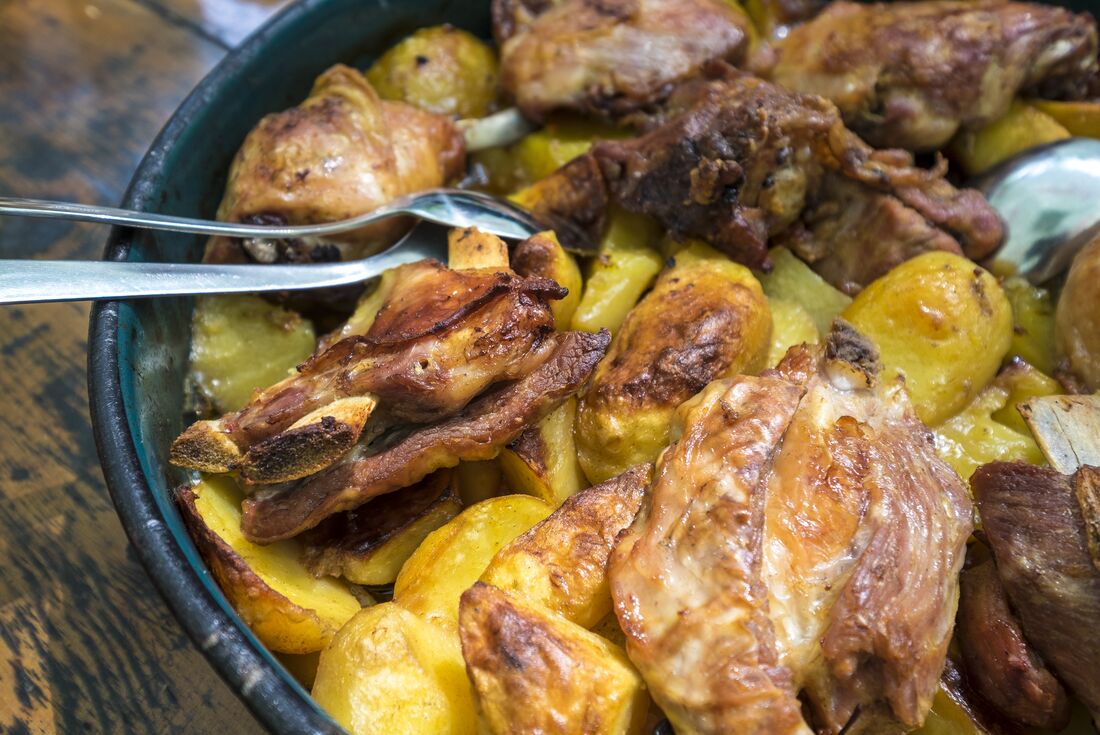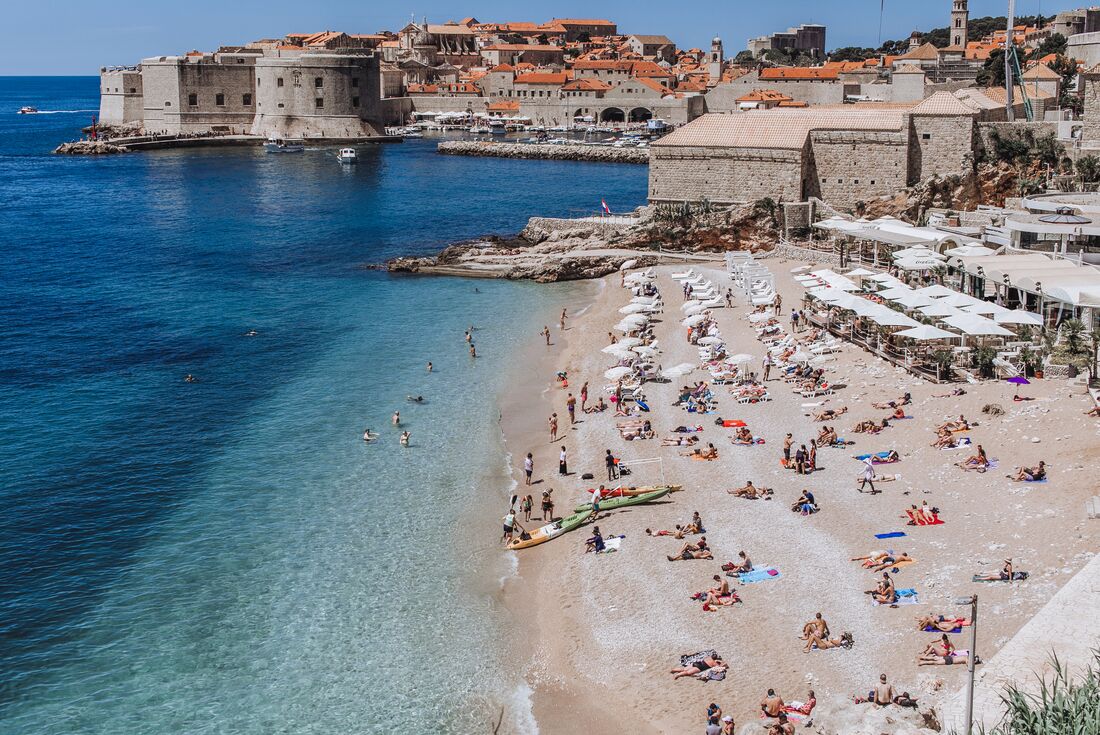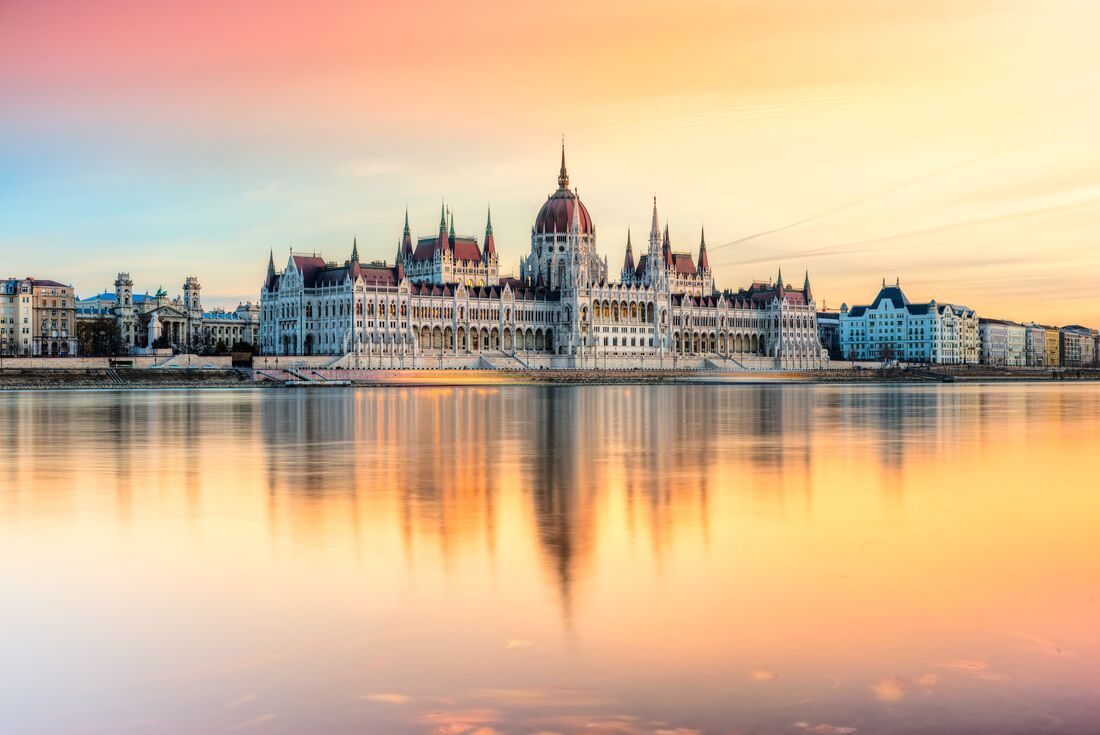- Sip the famous Croatian Traminac Premium wine at a wine tasting at a 15th century family-run vineyard in quaint Ilok
- Witness Mostar's famous bridge divers hurl themselves from the stones of a bridge that has spanned the river here for centuries
- Sarajevo is one of the most scenically located cities in Europe. See the sights on a guided walking tour and learn about its recent history as a city under siege
- Spend a full day exploring the green island of Mljet – with its small seaside villages, lush national park trails, shimmering waters and largely untouched environment, you’ll never want to leave!
- Stroll through Plitvice Lakes National Park, marvelling at luminous lakes and waterfalls that seem to have been sketched by an artist
07 Feb 2024
Budapest to Bled
WMSJC
Validity: 01 Jan 2024 to 31 Dec 2024
Stunning coastlines, historic cities, pristine national parks and some of the most delicious local cuisine your stomach will ever encounter – the Western Balkans have it all. And, this epic 29-day journey will show the best of it. Beginning in Budapest, which is also known as ‘the Pearl of the Danube’, you’ll have the chance to see a range of small towns, bright lights and natural wonders across Hungary, Serbia, Bosnia, Montenegro, Croatia and Slovenia. Your local leaders along the way will be able to give you insights into the different cultures you encounter, with a focus on the people, history and food.
Original
Explorer
Train,Public bus,Private vehicle,Ferry,Taxi,Tram
2
This trip can be enjoyed by just about anyone with a reasonable level of fitness. Some trips may have individual inclusions that may be of a higher physical rating compared to the overall rating of the trip. Please read the day-to-day itinerary carefully to find out more details on each day's activities, and whether they are suitable for you. Activities can be opted out of if you don't want to participate.
City Hotel Budapest
Dessewffy Utca 36
Budapest
HUNGARY
Phone: +36 14008972
City Hotel Budapest is a new property located in the heart of Budapest, near the famous opera house. The hotel offers a 24 hour reception, a bar and breakfast area, and the rooms include private bathrooms, TV, Wi-Fi access and hairdryer.
Budapest Ferenc Liszt International Airport (airport code BUD) is located 16km southeast of Budapest. Metered taxis are available from arrivals at all terminals. Alternatively you can catch frequent bus number 200E to the metro station at Kőbánya-Kispest, and then continue by metro line M3 to Arany János Utca metro station. Bus 100E is another option, delivering you right in the city centre at Deák Ferenc Tér, from where you can walk to the hotel (15 minutes), or change to metro line M3 for one stop to Arany János Utca metro station. From here it is just a 5 minute walk to City Hotel Budapest. Exit Arany János Utca metro station and cross the main road (Bajcsy Zsilinszky Utca). Turn left and then right again straight away into narrow Dessewffy Utca. City Hotel Budapest will be on your left after about 400 metres. If using public transportation and you change from a bus to the metro you will need a transfer ticket (2 physical tickets, validated one by one as you enter the bus/metro station). Make sure you validate your ticket as ticket checks on the metro are common. If in doubt about which ticket type to choose at the vending machine you can also buy your ticket at the tourist info in the airport's arrival hall. Pre booked arrival transfer from Budapest Airport (BUD): If you have pre booked an arrival transfer your transfer driver will be waiting in the arrivals hall, holding a board with the Intrepid Logo or your name on it. In case of flight cancellations, changes, if you experience severe delays at immigration, baggage collection or customs, or if you are not able to find the driver, please contact the transfer operator directly: +36 302 801 219.
Milena Rooms & Apartments
Gregorciceva ulica
Bled
SLOVENIA
Phone: +386 45744209
Located a 20-minute walk from the lake shore in a quiet residential area Milena Rooms & Apartments is surrounded by well-kept gardens. All rooms are located in the same building, however they differ in layout, can vary in size and all have shared facilities. This is the most effective way of staying in Bled. The nearest grocery store and a café are 200 metres away while the nearest bus stop can be found 300 metres away.
If you are making your own way to Lubljana Airport (airport code LJU) the guesthouse will be able to call a taxi or book a transfer for you. Alternatively there are public bus connections with a change in Kranj, or direct shuttle bus connections. If you have pre booked a departure transfer to Ljubljana Airport (LJU), you will be collected in front of the guesthouse 2.5 hours before your flight departure time. In case of flight cancellations, changes or if you are not able to find the driver, please contact the transfer operator directly: +386 31 682 961 or +386 402 00 484.
1. A single supplement is bookable on this trip, excluding Day 12&13, Day 21&22. Availability is limited due to small properties we use. Please speak to your booking agent for further information. 2.Please note that this trip is a combination of 3 separate stand-alone trips. Your leader and the composition of your group is likely to change on day 15 in Dubrovnik and on day 22 in Split. Please read the daily itinerary for more information.
All Intrepid group trips in Europe are accompanied by one of our local European group leaders. ’Local’ in this context means a leader who is European or lives in Europe. The aim of the group leader is to take the hassle out of your travels and to help you have the best trip possible. Intrepid endeavours to provide the services of an experienced leader however, due to the seasonality of travel, rare situations may arise where your leader is new to a particular region or training other group leaders. Your leader takes care of logistics, will provide information on the places you are travelling through, offer suggestions for things to do and see, recommend great local eating venues and introduce you to our local friends. While not being guides in the traditional sense you can expect them to have a broad general knowledge of the places visited on the trip, including historical, cultural, religious and social aspects. At Intrepid we also aim to support local guides in the individual cities or locations we travel to. If you are interested in delving deeper into the local culture at a specific site or location then your leader can recommend an optional local guide service in most of the main destinations of your trip.
Most national governments provide regularly updated foreign travel advice on safety issues involved with international travel. We recommend that you check your government's advice for their latest travel information before departure and ensure that your travel insurance covers you for all destinations and activities on your trip. Please refer to our website's safety page for links to major travel advisories and updates on safety issues affecting our trips here: https://www.intrepidtravel.com/travel-alerts We strongly recommend the use of a neck wallet or money belt while travelling, for the safe-keeping of your passport, flight tickets, cash and other valuable items. Leave your jewellery at home - you won't need it while travelling. Many of our hotels have safety deposit boxes, which is the most secure way of storing your valuables. A lock is recommended for securing your luggage. Your group leader or local representative will accompany you on all included activities, however, during your trip you'll have some free time to pursue your own interests or relax and take it easy. While your group leader or local representative will assist you with the available options in a given location, please note that any optional activities you undertake are not part of your Intrepid itinerary, and Intrepid makes no representations about the safety of the activity or the standard of the operators running them. Please use your own good judgement when selecting an activity in your free time. Please also note that your group leader or local representative has the authority to amend or cancel any part of the trip itinerary if it's deemed necessary due to safety concerns. Intrepid's operational safety policies can be viewed on our website at the link below. We recommend that you take a moment to read through this information before travelling, and would appreciate any feedback on how safety is being managed on our trips.
https://www.intrepidtravel.com/safety-guidelines
FIRE PRECAUTIONS: Please be aware that local laws governing tourism facilities in this region differ from those in your home country and not all the accommodation which we use has a fire exit, fire extinguishers or smoke alarms.
TRAFFIC AND DRIVING ON THE OTHER SIDE OF THE ROAD: Depending on where you come from please note that drivers in this part of the world may drive on the opposite side of the road from what you are used to. Look both ways before crossing any road. Traffic can be a little more chaotic than you might be used to at home. Be aware!
PETTY THEFT AND PERSONAL SAFETY While travelling there is always the risk of pick-pocketing and petty theft, particularly in the more touristy cities. We recommend that you exercise caution when walking alone at night and encourage you to walk together and only on main, well-lit thoroughfares. Be particularly vigilant on public transport. Simple measures like carrying your day pack on your front, not hanging your bag over the back of your chair or on the floor and wearing a money belt will reduce any chance that your valuables should go missing.
SCAMS Common scams operating in Europe include ploys to get you fined on the metro without a validated ticket. Ensure that you always travel with a validated ticket (have your ticket stamped). Another common scam is used by children who distract you with a map or a newspaper and while you are attending to them, steal your valuables. You may also come across players offering you to participate in the so-called "shell game". This is a scam and you will most certainly lose your money.
BIKE HELMETS: Please note that helmets are not always provided for sightseeing on bicycles.
SEAT BELTS: Please be aware that local laws governing transportation safety may differ from those in your home country and not all the transport which we use is able to provide seat belts.
PASSPORT You’ll need a valid passport to travel internationally and most countries require your passport to have a minimum of 6 months validity, so remember to check the expiry date. We need your passport information to get everything ready for your trip so it’s important that the information on your booking matches your passport exactly. Please take care to provide the correct details. We recommend carrying a copy of the photo page of your passport while travelling and leaving a copy at home with family or friends. VISAS & ENTRY REQUIREMENTS Many countries require a visa and obtaining the correct visa for your trip and any countries you may transit through is your responsibility. We recommend you check your visa requirements as soon as you have booked your trip. This will ensure you have time to prepare your documents and for your visa application to be processed. You can check the entry requirements for your nationality on your government's foreign travel advisories, consular websites or on our page here: www.intrepidtravel.com/visa-entry-requirements Visas for Hungary, Serbia, Bosnia & Herzegovina, Montenegro, Croatia and Slovenia are not required for passport holders of the European Union, Australia, New Zealand, USA and Canada. All other nationalities should check with the relevant authorities. BORDER CROSSINGS: Passports have to be carried however stamps are rarely issued at border crossings.
Sip the famous Croatian Traminac Premium wine at a wine tasting at a 15th century family-run vineyard in quaint Ilok
Witness Mostar's famous bridge divers hurl themselves from the stones of a bridge that has spanned the river here for centuries
Sarajevo is one of the most scenically located cities in Europe. See the sights on a guided walking tour and learn about its recent history as a city under siege
Spend a full day exploring the green island of Mljet – with its small seaside villages, lush national park trails, shimmering waters and largely untouched environment, you’ll never want to leave!
Stroll through Plitvice Lakes National Park, marvelling at luminous lakes and waterfalls that seem to have been sketched by an artist
Please be aware that the Balkan Peninsula and the Croatian coast are very hilly and mountainous, which means lots & lots of steps are an inherent feature of the landscape. You will have to be able to easily lift your luggage and carry it up and down stairs and inclines. Also, stone streets become very slippery when wet. Some people may find this region's topography very demanding. Summer temperatures can be extreme in many of the regions visited (over 40°C), which can be uncomfortable. It’s important to use sun protection, wear layers to combat the heat and drink plenty of water. Please carefully consider the time of the year you wish to travel and your suitability to that season. Please note that only some of our hotels and none of the public trains and buses in this region have air-conditioning. Hotels in Europe often don't have double beds, but rather two single beds that can be pushed together/apart. Rooms can be rather small, especially by American or Australian standards. Please also note that some of the accommodation used on this trip offer shared bathrooms rather than en-suite facilities. Please note that on the islands of Korcula and Hvar we are staying in private apartments that locals rent out during the summer months. These are located in various buildings spread across town, but all are within a 15-minute walk of the main square. The apartments are not hotels, which means there's no reception, room service or daily cleaning service, no televisions or washing machines, but plenty of charm. They differ in layout and facilities, can vary in size and most don't have air-conditioning and wi-fi. This is the most effective way of staying in the centre of town. Please also note that individual rooms are allocated on a same gender twin share basis, however the apartments itself are allocated on a mixed gender basis, which means you will be sharing a two, or three room apartment with the other members of the group. Apartments may only have one bathroom which will be shared between the group members staying in the same apartment. If you have booked a single room, you will be allocated one, however, this again will be a single room in a shared apartment with shared bathroom facilities, not a single or studio apartment. On this trip you must pack as lightly as possible because you will be expected to carry your own bag and although you won't be required to walk long distances with your luggage (max 30 minutes), we strongly recommend keeping the weight under 15kg / 33lb. Most travellers carry their luggage in a backpack, although an overnight bag with a shoulder strap would suffice if you travel lightly. Smaller bags or backpacks with wheels are convenient although we recommend your bag has carry straps to accommodate the cobbled streets, uneven surfaces, stairs and steps you are likely to encounter while carrying your luggage. You'll also need a day pack/bag to carry water and a camera etc for day trips.
GENERAL HEALTH All travellers need to be in good physical health in order to participate fully on this trip. For the safety and wellbeing of yourself and others, if you are unwell prior to travelling, please stay at home and contact us to make alternative arrangements. When selecting your trip please make sure you have read through the itinerary carefully and assess your ability to manage and enjoy our style of travel. Please note that if in the assessment of our group leader or local representative a traveller is unable to complete the itinerary without undue risk to themselves and/or the rest of the group, we reserve the right to exclude them from all or part of a trip without refund. You should consult your doctor for up-to-date medical travel information or for any necessary vaccinations before departure. We recommend that you carry a first aid kit as well as any personal medical requirements in their original packaging as they may not easily be obtained while travelling. If you are carrying medication, ensure you check your government's foreign travel advice for any local restrictions or requirements.
While travelling with us you'll experience the vast array of wonderful food available in the world. Your group leader will be able to suggest restaurants to try during your trip. To give you maximum flexibility in deciding where, what and with whom to eat, generally not all meals are included in the trip price. This also gives you more budgeting flexibility. As a rule our groups tend to eat together to enable you to taste a larger variety of dishes and enjoy each other's company. There's no obligation to do this though. VEGETARIANS Vegetarians might find the menu selection in Europe less varied than they would see at home. Vegetarianism is not as common in this region and generally the choices are basic, involving vegetables, soups, salads, bread, cheese, fruit, yoghurt, eggs etc. Vegans and those on gluten-free diets may find this region very challenging and may need to supplement meals with their own supplies from supermarkets and markets. Wherever possible we will cater for dietary needs for any included meals, but there may be times when those with special requirements may need to provide their own. BREAKFASTS There are some continental breakfasts included on this trip which may simply include bread/toast or pastries, butter, jam, coffee/tea/juice (or similar).
CURRENCY The local currency of Hungary is the Hungarian Forint (HUF), in Serbia it is the Serbian Dinar (RSD), in Bosnia & Herzegovina the Bosnian Convertible Mark (BAM), Croatia uses the Croatian Kuna (HRK), and Slovenia has adopted the Euro (EUR). Since independence Montenegro is now also using the common currency of the European Union, the Euro, even though they are not a member of the EU. CASH You can use your credit/debit card in ATMs, which are common throughout Europe. Before leaving home, check if your bank will charge fees for using your card internationally. Card payments are not always accepted in stores and restaurants. We recommend you carry some cash for these purposes. SPENDING MONEY When it comes to spending money on the trip, every traveller is a little different. You know your spending habits better than we do, so please budget an appropriate amount for things like optional meals, drinks, shopping, optional activities, and laundry. Make sure you have read the itinerary and inclusions thoroughly so you know what is included in the trip price and what you may need to pay for while travelling. BUDGET Please budget for additional meals and expenses while on your trip. We suggest EUR 935.00 for meals not included on this trip. Our suggestion is based on past traveller feedback but you may choose to spend more or less. TIPPING If you're happy with the services provided a tip - though not compulsory - is appropriate. While it may not be customary to you, it's of great significance to the people who will take care of you during your travels, inspires excellent service, and is an entrenched feature of the tourism industry across many Intrepid destinations. The following amounts are per person suggestions based on local considerations and feedback from our past travellers: In local markets and basic restaurants and cafes - round your bill up to the nearest €1. In more up-market restaurants we suggest 5% to 10% of your bill. Throughout your trip you may at times have a local guide in addition to your tour leader. We suggest €2-€3 per day for local guides. You may also have a range of drivers on your trip. Some may be with you for a short journey while others may be with you for several days. We would suggest a higher tip for those more involved with the group, however we suggest €1-€2 per day for drivers. You may also consider tipping your tour leader for outstanding service throughout your trip. The amount is entirely a personal preference, however as a guideline €4-€5 per person, per day can be used. Of course you are free to tip more or less as you see fit, depending on your perception of service quality and the length of your trip. Remember, a tip is not compulsory and should only be given when you receive excellent service. In total, we recommend you budget approx €5-€10 per day of your trip to cover tipping. CONTINGENCY FUNDS We try to plan for every eventuality, but there are still some things beyond our control. We reserve the right to change an itinerary after departure due to local circumstances or a Force Majeure Event. In such emergency circumstances, the additional cost of any necessary itinerary alterations will be covered by you. Please note we are not responsible for any incidental expenses that may be incurred as a result of the change of itineraries including but not limited to visas, vaccinations or non-refundable flights. Make sure you have access to an extra US$500 for emergencies (e.g. severe weather, natural disasters, civil unrest) or other events that result in unavoidable changes to the itinerary (e.g. transport strikes or cancellations, airport closures). Sometimes these things necessitate last-minute changes to enable our trips to continue to run, and as a result, there may be some extra costs involved. The recommended amount is listed in USD for the relatability of universal travellers, however, local currency may be needed once in the country to cover these costs.
PACKING On this trip you must pack as lightly as possible because you will be expected to carry your own bag and although you won't be required to walk long distances with your luggage (max 30 minutes), we strongly recommend keeping the weight under 10kg / 22lb. Most travellers carry their luggage in a backpack, although an overnight bag with a shoulder strap would suffice if you travel lightly. Smaller bags or backpacks with wheels are convenient although we recommend your bag has carry straps to accommodate the cobbled streets, uneven surfaces, stairs and steps you are likely to encounter while carrying your luggage. You'll also need a day pack/bag to carry water and a camera etc for day trips. You can find Intrepid's Ultimate Packing List on our website. It should be used as a guide only and isn't intended to be a complete packing list.
https://www.intrepidtravel.com/packing-list
TRAVELLING ON LOCAL TRANSPORT It's important that your bags can be locked, as on local transport it may be necessary that your luggage gets stowed separately (and unattended). The smaller your bag the better for you and other passengers. To ensure maximum comfort, try to pack small and light.
WATER BOTTLE Please bring your own water bottle to refill along the way. Although it can be difficult to avoid bottled water when travelling, please use the water dispensers which are provided on some of our vehicles and at some of our accommodation. Your group leader or local representative will advise whether tap water is safe to drink in your destination and if it is you can simply refill with tap water. When unable to avoid bottled water it is better to buy the largest available and distribute into your smaller bottle for the day. If you are walking or trekking as part of your trip you will need to carry at least 2L of water with you.
IMAGES FROM HOME During our trip, there will be many opportunities for you to meet and talk with locals. One way to start any conversation is with pictures. We recommend that you bring some photos/postcards of your family, home, city or country where you live, animals peculiar to your country, etc.
SUMMER Summer temperatures can be extreme in many of the regions visited (over 40°C/104°F), which can be uncomfortable. It’s important to use sun protection and drink plenty of water. Please carefully consider the time of the year you wish to travel and your suitability to that season. SHOULDER SEASON In contrast, weather in shoulder season can be unpredictable, and snow is not unheard of at higher altitudes. If you travel at the start or towards the end of the European season please pack accordingly with warm and/or waterproof clothes (preferably layers). The advantage of travelling during this time is that there are less tourists around.
We like to think our Intrepid travellers are all connected by a love of adventure and passion for seeing the world in a different way. We've laid down a few non-negotiable rules to ensure everyone feels connected, comfortable and safe on our trips. We ask that you respect your fellow travellers, group leader or local representative, and local people and places we visit in all circumstances. We don't tolerate any forms of violence and expect that you follow the local laws, customs and regulations in any destination we travel to. Any behaviour contrary to the above, including any behaviour that prevents our staff from performing their duty of care or continuing the itinerary as planned, may result in travellers being removed from the trip. If you consume alcohol while travelling, we encourage responsible drinking and expect you to abide by local alcohol laws. To ensure the well-being of everyone on the trip, all decisions made by group leaders or local representatives and ground staff are final. Romantic relationships between travellers and group leader or local representative are not permitted while on trip. By travelling with us, you agree to comply with these rules and the laws and customs of all countries visited. If something is concerning you during your travels with us, please speak to your group leader or local representative immediately. Alternatively, contact us on the emergency contact number detailed in your Essential Trip Information’s Problems and Emergency Contact section.
Can’t stop thinking about your adventure? Tell us all about it! We read each piece of feedback carefully and use it to make improvements for travellers like you. Share your experience with us at: http://www.intrepidtravel.com/feedback/
While we always endeavour to provide the best possible holiday experience, due to the nature of travel and the areas we visit sometimes things can and do go wrong. Should any issue occur while you are on your trip, it is imperative that you discuss this with your group leader or local representative straight away so that they can do their best to rectify the problem and save any potential negative impact on the rest of your trip. We recognise that there may be times when your group leader or local representative may not be able to resolve a situation to your satisfaction - if this is the case, please ask the group leader or local representative to speak to their direct manager. You may also choose to provide details in your online feedback, which we ask you to complete within 30 days of the end of your trip. Please do be aware that it is very difficult for us to provide any practical help after the trip is completed, so informing us while still travelling will give us the opportunity to resolve the issue in real-time. For general contact details please use the following page: http://www.intrepidtravel.com/ourtrips/contact/ If you have booked an arrival transfer, and you experience severe delays at immigration, baggage collection or customs, or if you are not able to find to the driver, please contact the transfer operator directly on the number listed in the joining point instructions in the section above. In the case of a genuine crisis or emergency, Intrepid's Europe Operations Team can be reached on the number listed below: Intrepid's Local Operator: +49 8024 4679 540
Our Responsible Travel Policy outlines our commitment to preserving the environment, supporting local communities, protecting the vulnerable, and giving back to the places we travel. All our trip group leaders or local representatives, suppliers, and staff are trained on these principles and are core to us delivering sustainable, experience-rich travel. Explore the different parts of our Responsible Travel Policy by visiting: https://www.intrepidtravel.com/responsible-travel DRESS CODE In general, there are few dress restrictions in Europe. When visiting churches, monasteries or other religious sites modest dress is required - shorts or sleeveless tops may not be permitted, for both men and women.
We created our not-for-profit, the Intrepid Foundation because you – our travellers – told us you wanted to make an even greater impact in the communities you visit. The Foundation works by teaming up with partners around the world so that together we can deliver greater positive impact at scale. Partners are identified by our local staff who live and work in our destinations. They harness their powerful community connections to determine the issues that matter most and select local partners who can deliver real solutions. Since 2002, the Intrepid Foundation has raised more than $14million dollars and supported more than 160 communities worldwide. Now, with over 40 partners all over the world, your donations are helping to restore forests in Kenya, empower women in Honduras and promote elephant welfare in Laos, to name just a few. For more information about the Intrepid Foundation, please ask your group leader or local representative or visit our website: http://www.theintrepidfoundation.org/
OCCASIONAL ALTERNATIVE ACCOMMODATION The style of accommodation indicated in the day-to-day itinerary is a guideline. On rare occasions, alternative arrangements may need to be made due to the lack of availability of rooms in our usual accommodation. A similar standard of accommodation will be used in these instances. TWIN SHARE BASIS Accommodation on this trip is on a twin/multishare basis. We pair up solo travellers with another traveller of the same gender as per the gender marker on each of their passports. Please note there may be times where facilities will be shared rather than ensuite and rare occasions when you share a room with passengers travelling on different Intrepid trips than your own. CHECK-IN TIME Throughout the trip we request that our hotels prepare rooms in time for our arrival, especially if we're arriving prior to normal check-in time. However this isn't always possible which means we won't be able to check-in immediately on arrival at some hotels. Instead, we can store our luggage and explore our new destination. PRE/POST TRIP ACCOMMODATION If you've purchased pre-trip or post-trip accommodation (if available), you may be required to change rooms from your trip accommodation for these extra nights. FACILITIES Your accommodation may not always have private en suite facilities or air-conditioning. European hotels generally don't provide kettles or fridges. PRIVATE APARTMENT ACCOMMODATION Please note that on the islands of Korcula and Hvar we are staying in private apartments that locals rent out during the summer months. These are located in various buildings spread across town, but all are within 15 minutes walk of the main square. They differ in layout and facilities, can vary in size and most don't have air-conditioning. This is the most effective way of staying in the centre of town.
TRANSPORT IN EUROPE Half the fun of travel is the travelling itself, that's why we like to travel the local way – whether that means mingling with commuters on a local train, watching the scenery roll by from the window of a long distance bus, arriving on a high speed train in the city centre of your next destination, or navigating each city's public transport system. In Europe, you are guaranteed to travel by genuine local public transport wherever possible, which puts you right in the centre of the action. LONG TRAVEL DAYS As we cover lots of ground on this trip, expect some long travel days on local trains and buses. This is an opportunity to mix with the locals and enjoy the scenery out the window. Travel schedules are known to change with little notice. Not all transport may have air conditioning.
Travel insurance is compulsory on all our trips for those travelling internationally. We require that at a minimum you are covered for medical expenses including emergency repatriation. If you are travelling within your home country or region please confirm before travel that you are entitled to access the public medical system easily should an accident occur. We strongly recommend all travellers have a policy that also covers personal liability, cancellation, curtailment and loss of luggage or personal effects. For international trips, you will not be permitted to join the group until evidence of travel insurance and the insurance company's 24-hour emergency contact number has been sighted by your group leader or local representative. If you have credit card insurance your group leader or local representative will require details of the participating insurer/underwriter, the level of coverage, policy number, and emergency contact number rather than the bank's name and your credit card details. Please contact your bank for these details prior to arriving in-country. For travellers who reside within the European Union, Switzerland or USA the requirement to purchase travel insurance cannot be compulsory. However the purchase of travel insurance is still highly recommended, and travellers from these regions who decline travel insurance when travelling outside of their home region must sign a Travel Insurance Waiver Form at the Group Meeting, recognizing personal responsibility for emergency medical and repatriation costs should they arise. For assistance with travel insurance or other services, please visit the link below: https://www.intrepidtravel.com/booking-resources/our-services
As you travel on a group trip you will be exposed to all the pleasures and maybe some of the frustrations of travelling in a group. Your fellow travellers will probably come from all corners of the world and likely a range of age groups too. We ask you to be understanding of the various needs and preferences of your group - patience with your fellow travellers is sometimes required for the benefit of everyone's travel experience. Remember too that you have responsibilities to the group. If you are requested to be at a place at a certain time, ensure that you don't keep the rest of the group waiting. We have found time and time again that the very best trips we operate are those where the dynamics within the group work well - this takes just a little effort on your part. Due to privacy reasons, we are unable to provide you with contact details and any personal information about your fellow travellers booked on your trip prior to departure. SOLO TRAVELLERS The beauty of our style of travel is that it caters to travellers who are travelling solo and who want to meet and share experiences with like-minded people. On our trips rooming is organised on a twin-share basis. We pair up solo travellers with another traveller of the same gender as per the gender marker on each of their passports. As a responsible tour operator, we strive to create a safe and inclusive environment for everyone. In the case that your gender identity differs from what is indicated on your passport, please contact us so that we can discuss rooming options with you. We also have an optional single supplement available on most trips for travellers who prefer to have their own room. Please note that this only applies to accommodation during the tour. Pre-trip and post-trip accommodation booked through us will be on a single room basis. On a small selection of itineraries some accommodations are booked on an open gender, multi-share basis (for example on a felucca in Egypt or an overnight train in Vietnam). In those instances it will clearly be stated in our Essential Trip Information prior to booking and travelling.
ITINERARY CHANGES Our itineraries are updated regularly throughout the year based on customer feedback and to reflect the current situation in each destination. The information included in this Essential Trip Information may therefore differ from when you first booked your trip. It's important that you review this information prior to travel so that you have the latest updates. Due to weather, local conditions, transport schedules, public holidays, political unrest or other factors, further changes may be necessary to your itinerary once in-country. Your group leader or local representative will keep you up to date with any such changes once your trip is underway. OPTIONAL ACTIVITIES A selection of optional activities that have been popular with past travellers are listed in the day-to-day itinerary. This isn't an exhaustive list and should be used as a guide only for some of what might be available. Prices are approximate, are for entrance fees only, and don’t include transport to and from the sites or local guides unless indicated. All activities are subject to availability, and maybe on a join-in basis. It may not be possible to do all the activities listed in the time available at each destination, so some pre-planning for what you are most interested in is advised. When it's recommended that travellers pre-book these activities, look for a note in the Special Information section of the day-to-day itinerary. For most, they can either be organised independently on the day, or let your group leader or local representative know you are interested at the Welcome Meeting and they can assist. Where activities are considered medium or high risk, we work with operators whose safety and credentials we have sighted and assessed. Although it is possible that you may find the same activity cheaper with another operator on the ground, we cannot vouch for the safety or quality of that operator. Medium and high-risk activities not listed above have not been assessed by us and as such our staff and group leader or local representative are unable to assist you with organising these activities. Activities that contravene our Responsible Travel policies are also not listed. Please remember that the decision to partake in any activity not listed is at your own discretion and risk. MUSEUM VISITS & OPENING TIMES Many sites, attractions and museums are closed on Mondays (and sometimes Tuesdays). We recommend checking the opening times of anywhere you're interested to visit and making reservations where required/possible. COMBINATION TRIP Please note that this trip is a combination of two or more stand-alone trips. Your leader and the composition of the group will most likely change part-way through the trip. You can find details on where and on which day these changes are taking place in the daily itinerary.
Hotel (12 nights),Guesthouse (4 nights),Hostel (3 night),Pension (9 nights)



